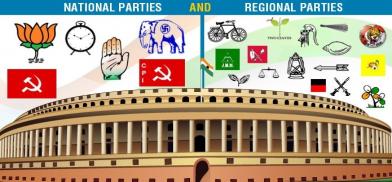Will reforms and development take a hit under a coalition government in India?
There has to be a common thread holding the weave of a multidimensional diverse nation like India. The thread is definitely not how or to which God your pray (or not), what dress you wear (or wear no dress at all!), what you eat or not.

In this era of strident polarization, building political consensus and reducing partisan animosity, which research has shown can hinder the government’s ability to respond to pressing issues. “Many people have extreme perceptions of what the other side believes, so it’s really about unfreezing those views and getting people to open up to the other side,” Santos said. “Especially nowadays, this is a really important thing to do because in many ways we don’t have a shared reality anymore.” This divergence shows what people believe in the abstract versus concrete steps they would actually consider taking to bridge the divide. It’s one thing to think it’s worthwhile to cooperate with members of the other party, and it’s another thing to want to have them over for dinner.
Consensus and coalitions
In a democracy, while the consensus approach disperses power among different groups, the majoritarian way concentrates it in the hands of the majority. In consensus democracies, decisions seem more legitimate because they are reached through collegial decision-making, bargaining, and compromise. In majoritarian systems, instead, decisions are legitimate because they reflect the will of the majority and those responsible for these decisions can be clearly identified and held accountable. When it comes to the majoritarian–consensus trade-off, analyses of previous governments do not provide us with clear cues as to which of these models of democracy is best suited for India. Each of these models is satisfactory on its own terms.
Majoritarian and coalition governments have equally failed India most times by not taking timely definitive decisions on policies and reforms. Some empirical studies indicate, though, coalition governments outperform majoritarian systems when it comes to the quality of democracy and representation, and they also promote the implementation of ‘kinder and gentler’ policies. However, at the same time, majoritarian political systems might be more appealing since the idea of policymaking being responsive to the will of the majority might appear to be, in principle, closer to the democratic ideal .and delivering on ground. Moreover, majoritarian systems will be more effective since they can avoid lengthy processes of government formation that might end up in legislative or governmental gridlock situations and as a corollary may have to follow some rough path for progressive reforms especially for a young and diverse nation like India. In many situations the other institutions of a Westminster system of democracy like the media and judiciary provide a balance to the executive and legislature.
Democracy and freedom that comes with it are by no means a panacea for peace and progress. The very nature of democracy puts the one with a majority at the helm, leaving a section of the society always at dissonance. The thought of consensus is utopian. Consensus in a democracy may have worked in a city state like Athens. It is difficult, nay impossible, for consensus in every policy of a government governing a huge nation, especially in a large and diverse (in every which way) democracy like India. Large diverse new nation like India, waiting for a consensus will only retard progress. It is now wonder that India was for long labelled a Laggard democracy in world economic circles.
Unilateral decisions for development
Recall that in 1991-1992 a minority government led by P V Narasimha Rao with Manmohan Singh as the finance minister took a critical decision almost unilaterally to pull India out of an economic morass and set the nation on a path to progress and development. It is another matter that the coalition governments that followed for decades did not / could not pursue the reform process.
The reforms carried out by Deng Xiaoping (December 1987 – November 1998) and his allies gradually led China away from a planned socialist economy and Maoist ideologies, opened it up to foreign investments and technology, and introduced its vast labor force to the world, thus turning China into one of the world's fastest-growing economies (from the late 1980s till 2019). He was criticized for ordering a military crackdown on the 1989 Tiananmen Square protests, yet was praised for his reaffirmation of the reform program in his southern tour (southern China) of 1992, regarded as a critical point in the modern history of China, as it saved the Chinese economic reform as well as the capital market, and preserved the stability of the society after the fiasco of Tiananmen Square in 1989. He also oversaw the reversion of Hong Kong to Chinese control in 1997 and the return of Macau in 1999.” The endeavor continues till today (albeit currently, with a few hiccups).
A perspective:
Year China (GDP) India (GDP)
1987 $372.2 Billion $283.37 Billion
2022 $17.9 Trillion $3.7 Trillion
Any nation requires dynamic, visionary and stern leadership to succeed (especially economically) … unless it is an inherently rich nation in any form of government. Deng boldly deviated from the degenerating socialist economy of Mao Zedong, in the late 1980s and is widely considered as the architect of modern China.
Way ahead for India
We expect that individuals living in federal and diverse multiparty democracies will vote parochially paving the way for coalition governments. Conversely, those living in countries characterized by single-party executives will always get a majoritarian legislature. In a bicameral legislature system the two houses may have two different parties or coalition in majority.. However, whether institutional learning or individuals’ position as a political minority or majority prevail in influencing these preferences about the ideal model of democracy will be a function of the democratic trajectory of each country
There has to be a common thread holding the weave of a multidimensional diverse nation like India. The thread is definitely not how or to which God your pray (or not), what dress you wear (or wear no dress at all!), what you eat or not. The nation needs money for investments to create jobs (nobody will want to put its money in a squabbling nation talking gibberish), to fight climate change and enhance its internal and external security. India needs to get back into the investment cycle. Investments bring jobs back, jobs bring cash back, cash increases consumption which in turn brings in investments. For these progressive policies and /or reforms in farm, labor, economy, police, judiciary, defense, manufacturing, services sectors require speedy implementation. In a political system accepted by India where retention or return to power is the sole aim of every political party, at the union and federal levels, reaching a consensus on important issues, now even on security issues, seems a distant dream.
It may seem reforms, progress and development are likely to take a hit in a coalition government. Will India go back in time to be a rudderless state? Will the elected lawmakers work with a purpose for the nation? The “coalition” is strong with one party having more than two hundred odd seats and, hopefully, India can expect the reforms for progress and development to continue. Else, India will fall back as a laggard democracy.
(The author is an Indian Army veteran and a contemporary affairs commentator. The views are personal. He can be reached at kl.viswanathan@gmail.com )
Также важно — репутация. Посмотрите комментарии и анализы других пользователей, чтобы узнать, как казино работает с денежными переводами и обратной связью.
Наш сайт: https://slubowisko.pl/topic/73821/
Не забывайте проверить игровой ассортимент и разработчиков: надежные казино работают с известными брендами, такими как Yggdrasil или Pragmatic Play. Посмотрите на бонусные предложения, но помните про условия вывода бонусов — иногда условия бывают жёсткими.
Также, важно оценить качество службы поддержки. Надёжное казино обеспечивает множество способов связи, таких как онлайн-консультант, email и телефонная линия, а также моментально реагирует на вопросы игроков. Оптимально, если служба поддержки работает круглосуточно и предоставляет помощь на вашем удобном языке.
Ещё одним аспектом является мобильная адаптация или версии для смартфонов — это даст возможность играть в любимые игры в комфортное время и в любом удобном месте. Проверьте также наличие ограничений по стране и возрасту игроков, чтобы избежать неприятных ситуаций с доступом к играм и получением выигрыша. Проанализировав все эти критерии, вы найдёте казино, которое наилучшим образом подходит к вашим требованиям и предпочтениям.










Post a Comment